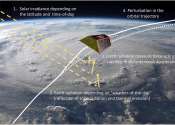Climate models use quantitative methods to simulate the interactions of the atmosphere, oceans, land surface, and ice. They are used for a variety of purposes from study of the dynamics of the climate system to projections of future climate.
All climate models take account of incoming energy as short wave electromagnetic radiation (which in this context means visible and ultraviolet, not to be confused with shortwave) to the earth as well as outgoing energy as long wave (infrared) electromagnetic radiation from the earth. Any imbalance results in a change in the average temperature of the earth.
The most talked-about models of recent years have been those relating temperature to emissions of carbon dioxide (see greenhouse gas). These models project an upward trend in the surface temperature record, as well as a more rapid increase in temperature at higher altitudes.
Models can range from relatively simple to quite complex:
This is not a full list; for example "box models" can be written to treat flows across and within ocean basins. Furthermore, other types of modelling can be interlinked, such as land use, allowing researchers to predict the interaction between climate and ecosystems.









